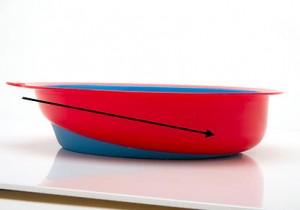Inspired by her late grandmother who had Alzheimer’s disease, Sha Yao, an industrial designer, developed Eatwell: a user-centered tableware set designed to help increase food intake and maintain dignity for those with Alzheimer’s. Her product won first place at 2014 Stanford Design Challenge out of 52 teams from 15 countries.
Firm in her commitment to improve the quality of life for those with Alzheimer’s, Yao set out to understand more about their lives. Through volunteering, she discovered that eating was one of the most challenging daily activities. Many, she realized, had the same problems as her grandma. They ate less than usual and spills were more frequently, potentially making a mealtime experience more stressful and challenging for both caregivers and their loved ones. Further still, once a patient stops eating or has general problems eating enough, their health condition often rapidly worsens. All this knowledge and her own personal experiences as her grandmother’s caretaker inspired her to create Eatwell.
After reading a Boston University study on the impact of bright colors, Yao realized the smallest of details could greatly enhance the quality of life for both sufferers and caregivers. The study found that when presented with flatware featuring bright colors, dementia patients were significantly more likely to consume food and beverages.
Every detail in the set was crafted with the patient’s well-being and dignity in mind. Each Eatwell set includes over 20 unique features to help make the process of eating as easy as possible. Every design detail and decision can be traced back to a finding or discovery made during the development process. Some features are directed to alleviate cognitive impairments, while other features address motor impairments
For example, the contrast in colors between the interior and exterior of the bowls allow the user to distinguish food from the bowl itself. White plates can confuse patients about where the food is and can cause frustration. Each bowl includes a slanted basin that collects food stuffs on one side for easier gathering. One side of each bowl is right angled to provide a surface to scoop against.
The exterior of each bowl is typically bright in color to stimulate appetite, while the interior has a high contrast finish to help distinguish the bowl from food.
The spoons have been engineered to match the curvatures of the bowl exactly. The anti-tipping cup includes a sturdy, wide base that resists tipping from short drops and bumps.
These are just some of the innovations engineered by Yao.
For more information, visit: http://www.eatwellset.com/

